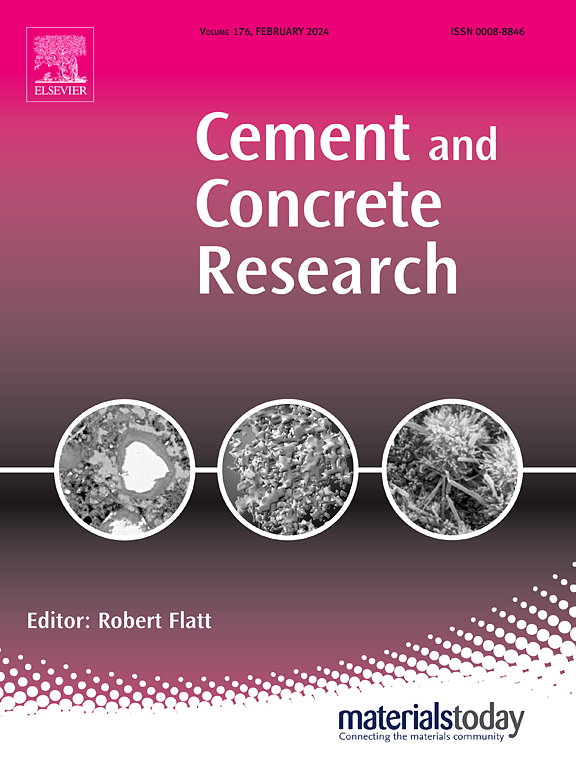Development of in-situ highly active calcium carbonate through anhydrous carbonation of OPC: Effect on hydration and properties of cement composites
IF 13.1
1区 工程技术
Q1 CONSTRUCTION & BUILDING TECHNOLOGY
引用次数: 0
Abstract
Cement production generates a significant amount of CO2. This paper presents a novel technique requesting CO2 capture during cement production, namely anhydrous carbonation (AC). By introducing CO2 during the grinding stage of cement production, which involves mechanochemical effects, this method enhances the carbonation of cement to produce carbon-enriched cement. The results indicated that calcium carbonate was formed in situ on the surface of cement after AC. Compared with the Ref samples, at curing of 1d, the compressive strength of AC-30 min, AC-1 h, and AC-3 h samples increased by 18.1 %, 40.0 %, and 22.9 %, respectively, the 28-day compressive strength increased by 7.5 %,17.1 %, and 12.3 %, respectively. AC facilitated the dissolution of OPC clinkers and the subsequent precipitation of hydration products. The enhancement of OPC performance after AC is primarily attributed to several factors. First, highly active calcium carbonate was generated on the surface of the cement clinker, providing nucleation sites for the hydration products of OPC. Additionally, this calcium carbonate participated in chemical reactions, reacted with C3A during hydration and formed Mc and Hc. Furthermore, the filling effect of unreacted calcium carbonate, combined with the formation of hydration products such as AFm, C-S-H, AFt, Mc, and Hc, contributed to the refinement of the pore structure. This research indicated that 14.4 kg of CO2 could be captured for every ton of cement produced, which suggests that anhydrous carbonation holds substantial potential for CO2 sequestration during the cement production process, which could significantly contribute to reducing CO2 emissions in the industrial production of cement.
OPC无水碳化制备原位高活性碳酸钙:对水泥复合材料水化及性能的影响
水泥生产会产生大量的二氧化碳。本文提出了一种新技术,要求在水泥生产过程中捕获二氧化碳,即无水碳化(AC)。该方法通过在水泥生产的磨矿阶段引入二氧化碳,这涉及到机械化学效应,从而增强水泥的碳化作用,从而生产出富碳水泥。结果表明,AC-30 min、AC-1 h和AC-3 h的抗压强度与Ref相比分别提高了18.1%、40.0%和22.9%,28天抗压强度分别提高了7.5%、17.1%和12.3%。AC有利于OPC熟料的溶解和水化产物的沉淀。交流后OPC性能的增强主要归因于几个因素。首先,在水泥熟料表面生成高活性碳酸钙,为OPC水化产物提供成核位点。此外,这种碳酸钙还参与了化学反应,在水化过程中与C3A反应形成Mc和Hc。此外,未反应的碳酸钙的填充作用,结合AFm、C-S-H、AFt、Mc、Hc等水化产物的形成,有助于孔隙结构的细化。该研究表明,每生产一吨水泥可捕获14.4千克二氧化碳,这表明无水碳化在水泥生产过程中具有巨大的二氧化碳封存潜力,这将大大有助于减少水泥工业生产中的二氧化碳排放。
本文章由计算机程序翻译,如有差异,请以英文原文为准。
求助全文
约1分钟内获得全文
求助全文
来源期刊

Cement and Concrete Research
工程技术-材料科学:综合
CiteScore
20.90
自引率
12.30%
发文量
318
审稿时长
53 days
期刊介绍:
Cement and Concrete Research is dedicated to publishing top-notch research on the materials science and engineering of cement, cement composites, mortars, concrete, and related materials incorporating cement or other mineral binders. The journal prioritizes reporting significant findings in research on the properties and performance of cementitious materials. It also covers novel experimental techniques, the latest analytical and modeling methods, examination and diagnosis of actual cement and concrete structures, and the exploration of potential improvements in materials.
 求助内容:
求助内容: 应助结果提醒方式:
应助结果提醒方式:


